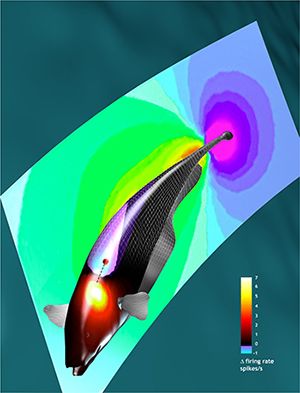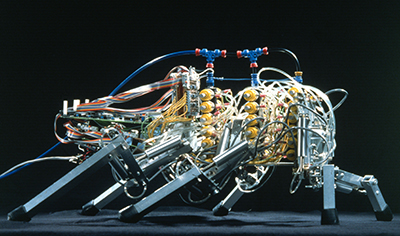From weakly electric fish to a robotic cockroach to a novel approach to using wireless networks for emergency response, Mark E. Nelson’s research career exemplifies the interdisciplinary approach that the Beckman Institute pioneered.

And why wouldn’t it? When Nelson accepted his first academic position 28 years ago, he not only joined the Illinois faculty as an assistant professor in the department that is now molecular and integrative physiology, but he joined the Beckman Institute as a full-time faculty member.
At that time, Beckman had been open only two years and was one of the first institutes designed for collaborative research.
“I can't imagine a better place to do this sort of work,” said Nelson, who lists his research interests as computational neuroscience, neural coding, and biological signal processing. “(My research has) included physics, biology, robotics. When I interviewed here. I thought, ‘Oh, this is perfect.’ And it has just always been a natural fit.”
Nelson, now a full professor, also serves as associate head of molecular and integrative physiology, and throughout his career, he has held appointments with the Beckman Institute, bioengineering, biophysics, and neuroscience.
With his Ph.D. from the University of California, Berkeley, he might have gone on to be a content experimental high energy physicist, but everything changed with his postdoctoral research studies at CalTech, where he became involved in a new program called computation and neural systems.
“The program brought together neurobiologists, engineers, and computer scientists to try and study the brain from a cross-disciplinary perspective,” Nelson said.
His interest in the field grew and he was impressed with how fast things seemed to be moving in the area of study. So he made the transition to neuroscience and never looked back. He brought the research with him to Illinois and set up an electric fish lab at the Beckman Institute.
“The main theme has always been the electric fish work, which spans behavior to neural computation,” Nelson said.
These nocturnal fish generate a weak electric field, which they use to detect objects in the dark. His Electrosensory Signal Processing Lab studied how weakly electric fish acquire information about their surroundings using the electric sense.
“Over time we also became interested in bats and dolphins and other animals with sensing systems,” Nelson said. “We broadened the scope and considered what's the commonality and the shared principles. And you learn by comparing across these different examples of animals that have adapted the strategy.”

Over the years, he became involved in different collaborative projects, including bio-robotics with Fred Delcomyn, now a professor emeritus of entomology, which resulted in the creation of insect robots.
“The focus was on understanding the interaction between the brain, body, and environment,” Nelson said. “But the sort of novel thing there was to think of the legs not only as actuators that move the robot forward, but also as sensors.”
So a large robotic cockroach was built, with legs that could get feedback from the ground as it walked. “Our goal was to understand how we could use that for agile locomotion. The robot that we built was pretty big (about 2-feet long) and it was driven by pneumatic air cylinders so it was really loud,” he said.
The large robotic cockroach drew the attention of columnist Dave Barry. In 1995, Barry wrote a column about how the scientific community “has completely lost its mind.” One of his examples was the robotic cockroach built at Illinois, citing a possible future scenario where the robotic roach comes to life and terrorizes the town.
Nelson also has taught courses over the years, including two mainstays: a large introductory neurobiology course that allowed him to teach from the molecular level all the way up to cognitive neuroscience and emotions and language; and a smaller class called “Brain Behavior and Information Processing,” which Nelson explains are all his interests turned into a course.
Nelson will retire from the university May 31, and he said the timing feels right. “It feels like I completed a chapter … or volume … here, and I’m ready to start a new chapter.”
He plans to combine his love of the outdoors with service through a volunteer organization called Wilderness Volunteers. The group partners with the National Forest Service and volunteers go in for a week and work with local rangers to do trail and habitat restoration.
“I get to spend time outdoors, visit national parks, and do something positive and give back,” Nelson said.
Editor's Note: Mark Nelson was featured in a Beckman Tower Talk in the summer of 2018. His talk, "What Does a Brain Do?" can be viewed online.